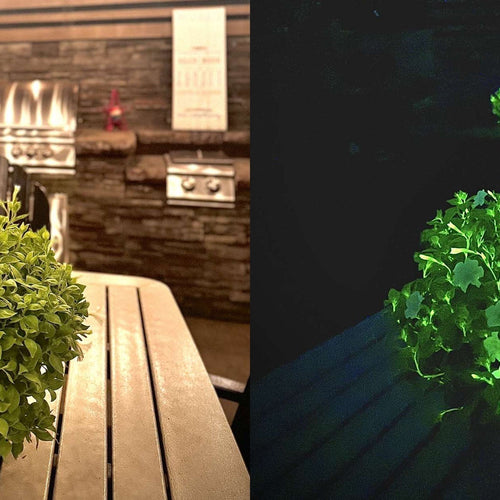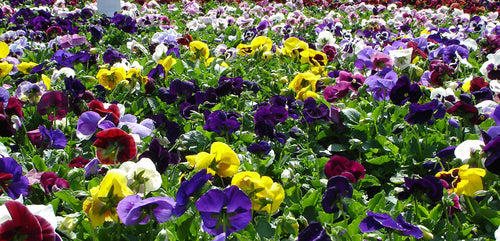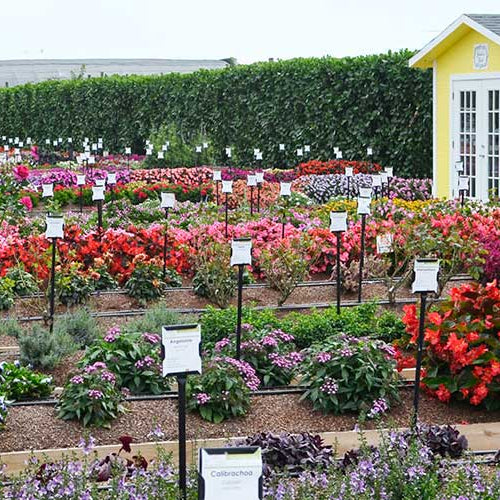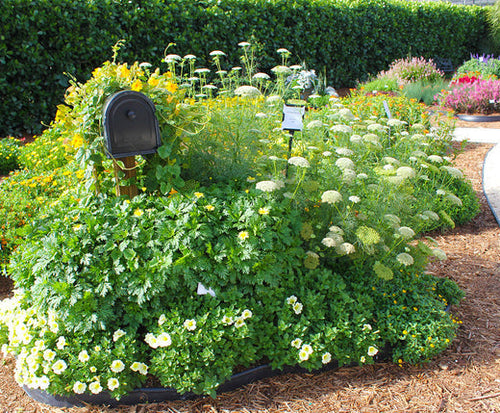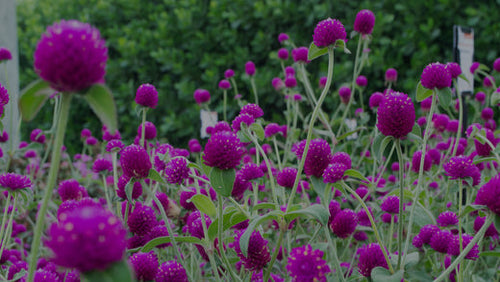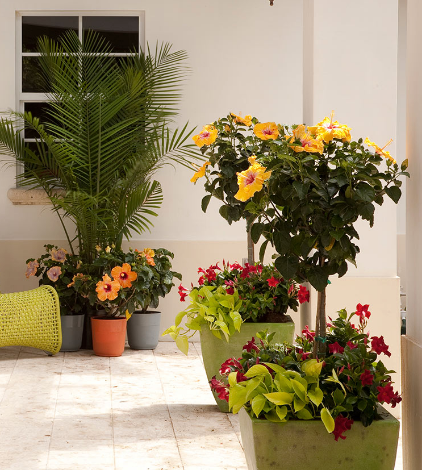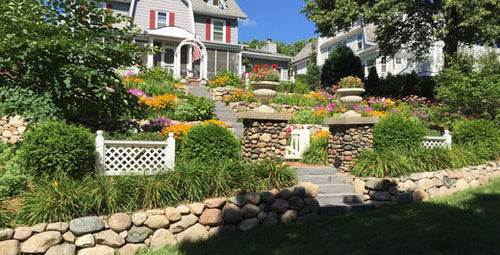
Pentas
Hot weather won’t stop pentas from putting on a summer-long show in your garden. This easy-care annual produces multitudes of small, star-like blooms that are clustered together in broad, showy flower heads. The plants grow 18 to 24 inches tall and work great in both mixed containers and flowerbeds. Colors include pink, red, white, and lavender. Pentas flowers are also packed with nectar that’s guaranteed to attract hordes of hungry butterflies and hummingbirds to your garden.

Marigold
Some flowers need no introduction. Marigolds, for example, have been a colorful and reliable staple in American gardens for generations. In fact, in the 1960s, marigolds had become so popular that Senator Everett Dirksen of Illinois introduced legislation to adopt this cheerful annual as our national flower. Marigolds come in both compact (8 to 12 inches tall) and standard (18 to 36 inches tall) varieties. Both types produce a seemingly endless supply of pungent, ball-shape, yellow, orange, white, red, or bi-color blooms on top of bright green, finely divided foliage. Super easy to grow, marigolds thrive in heat and drought.

Gazania
Capture the colors of a summer sunrise by adding a generous helping of gazania to your garden. Also called African daisy, gazania grows 6 to 12 inches tall and produces beautiful jewel-like flowers of yellow, orange, rose, white, and bi-color that stand perkily above the divided, dark green leaves. The flowers are true sun lovers, closing up at sunset and popping back open as soon as the sun returns in the morning. Use gazania in containers, rock gardens, or at the edge of a garden path. These little gems thrive in poor soil and hot, dry conditions and will attract plenty of butterflies to your garden.

Lantana
A few popular summer flowers live double lives. Lantana, for example, grows into a reliable flowering shrub in frost-free regions, but in the North, it acts like an annual, blooming its head off until freezing weather stops the show. Lantana revels in hot, sunny locations, and grows well in containers or directly in beds and borders. Popular with butterflies that feast on its nectar-rich flowers, lantana generally grows 12 to 36 inches tall and thrives in poor, dry soil. Flower colors include red, yellow, white, orange, lavender, pink, and bi-color. It’s deer and rabbit resistant as well as salt tolerant, making it a good choice for seaside locations.

Celosia
When it comes to bright color, few annuals can compare with celosia. The blooms of this summer favorite are so vivid, they stand out in borders and beds, delivering coveted curb appeal. Available in two main types, plumed or cockscomb, celosia produces flowers all summer long in super-intense shades of scarlet, yellow, pink, and red. Celosia grows 14 to 24 inches tall and looks terrific in containers or in mixed beds. Or, if you really want to stop traffic, plant it in a big bed by itself. A few varieties also offer bronze or purple-flushed foliage. Celosia also makes an excellent fresh or dried cut flower.

Portulaca
Imagine being able to grow your own magic carpet! It’s really easy when you let portulaca weave a pattern of colorful flowers in your garden. Also called moss rose, this fast-growing ground hugger produces a seemingly nonstop supply of pink, rose, yellow, white, red, or salmon single or double flowers atop a dark green mass of needle-like foliage. Portulaca grows 4 to 6 inches tall and thrives in hot, sunny locations and is easily tucked between bricks and pavers. It also makes an excellent container or basket plant. Portulaca flowers close at night and frequently self-sow, so a new crop of plants may emerge every spring.

Canna
The queen of the flower border, the regal canna towers over lower growing annuals with its spikes of tropical flowers and handsome broad green, bronze, or striped leaves. Because cannas come in compact (18 to 24 inches tall) and standard (36 to 72 inches tall) varieties you can use them in a variety of ways. For example, you can mix compact varieties in large tubs and containers with other annuals or use them en masse along a pathway or drive. Standard cannas make excellent privacy screens and are a great way to fill up large open spaces in your landscape. Cannas are a snap to grow, too. Just plant them in a sunny location with well-drained soil and stand back. Before you know it they’ll be reaching for the sky and producing spikes of red, yellow, pink, or bi-colored flowers that hummingbirds flock to all summer long.

Hibiscus
Turn up the heat in your garden with hibiscus. These tropical beauties produce huge trumpet-shape blooms on tall, bushy shrubs that can grow 3 to 5 feet tall. Hibiscus colors include yellow, red, pink, orange, and a host of bi-colors and tie-dye-inspired patterns. Use hibiscus in large tubs or containers or line them up along a walkway or path. In frost-free regions hibiscus makes a reliable landscape plant. In the North, bring your plants indoors before the first frost and use them as houseplants. The plants’ big, bold blooms will also attract colorful hummingbirds to your garden.

Petunia
What can you say about petunias that hasn’t already been said? These reliable annuals are probably the most popular flower in America -- and deservedly so. They offer a wide range of flower types, colors, and patterns and they happily grow in pots, planters, baskets, and flower beds. They also thrive anywhere as long as they get plenty of sun. Petunias, especially the ground cover varieties, are also great at stretching out and covering bare spots in your landscape. Many varieties are fragrant and all types are attractive to butterflies, hummingbirds, and other pollinators.

Dahlia
Available in almost any color or size you need, dahlias make a delightful addition to any sunny garden. Use compact dahlias, which stay under 24 inches tall, in pots or baskets, medium height varieties that reach stay between 2 and 3 feet tall in a mixed flower border or large tub, and place tall specimens that can reach 6 feet tall with dinner-plate sized blooms in the back of the border or along a fence or wall. All dahlias require full sun, and rich, well-drained soil. You can grow dahlias from seeds, tubers, or young plants purchased at your local garden center. In colder climates you can dig and store the roots in a cool, dry place over the winter.

Bidens
One of the most popular annual flowers for hanging baskets and window boxes, bidens is prized for its wiry, semi-trailing stems and cheerful yellow or bi-color daisy-like blooms. The plants grow 6 to 10 inches tall and 10 to 14 inches wide and seem to be in almost constant bloom. Bidens loves sunshine and hot weather and the nectar-rich blooms attract butterflies, bees, and other pollinators. The plants make good neighbors in a mixed basket because they bloom all summer and won’t smother their neighbors. Deadheading isn’t necessary, but if your plants start to get leggy give them a quick haircut and new crops of flowers will appear before you know it.

Sunpatiens
Modern plant breeding is an amazing thing: Once relegated to the shady corners of backyards, impatiens were given an upgrade by plant breeders who created SunPatiens, a vigorous new form that thrives in sunny spots. Growing 2 to 3 feet tall (compact varieties are a bit shorter) and wide, SunPatiens produce a constant supply of disc-like red, orange, lavender, white, salmon, or pink blooms atop a canopy of dark green or colorfully variegated foliage. Use SunPatiens in pots, planters, or directly in the landscape. They prefer rich, slightly moist soil, but can be surprisingly tolerant of hot, dry conditions. Hummingbirds also flock to the nectar-rich blooms.





